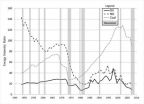(Press-News.org) DURHAM, N.C. – As the U.S. Environmental Protection Agency weighs whether to define coal ash as hazardous waste, a Duke University study identifies new monitoring protocols and insights that can help investigators more accurately measure and predict the ecological impacts of coal ash contaminants.
"The take-away lesson is we need to change how and where we look for coal ash contaminants," says Avner Vengosh, professor of geochemistry and water quality at Duke's Nicholas School of the Environment. "Risks to water quality and aquatic life don't end with surface water contamination, but much of our current monitoring does."
The study, published online this week in the peer-reviewed journal Environmental Science and Technology, documents contaminant levels in aquatic ecosystems over an 18-month period following a massive coal sludge spill in 2008 at a Tennessee Valley Authority power plant in Kingston, Tenn.
By analyzing more than 220 water samples collected over the 18-month period, the Duke team found that high concentrations of arsenic from the TVA coal ash remained in pore water -- water trapped within river-bottom sediment -- long after contaminant levels in surface waters dropped back below safe thresholds. Samples extracted from 10 centimeters to half a meter below the surface of sediment in downstream rivers contained arsenic levels of up to 2,000 parts per billion – well above the EPA's thresholds of 10 parts per billion for safe drinking water, and 150 parts per billion for protection of aquatic life.
"It's like cleaning your house," Vengosh says of the finding. "Everything may look clean, but if you look under the rugs, that's where you find the dirt."
The potential impacts of pore water contamination extend far beyond the river bottom, he explains, because "this is where the biological food chain begins, so any bioaccumulation of toxins will start here."
The research team, which included two graduate students from Duke's Nicholas School of the Environment and Pratt School of Engineering, also found that acidity and the loss or gain of oxygen in water play key roles in controlling how arsenic, selenium and other coal ash contaminants leach into the environment. Knowing this will help scientists better predict the fate and migration of contaminants derived from coal ash residues, particularly those stored in holding ponds and landfills, as well as any potential leakage into lakes, rivers and other aquatic systems.
The study comes as the EPA is considering whether to define ash from coal-burning power plants as hazardous waste. The deadline for public comment to the EPA was Nov. 19; a final ruling -- what Vengosh calls "a defining moment" -- is expected in coming months.
"At more than 3.7 million cubic meters, the scope of the TVA spill is unprecedented, but similar processes are taking place in holding ponds, landfills and other coal ash storage facilities across the nation," he says. "As long as coal ash isn't regulated as hazardous waste, there is no way to prevent discharges of contaminants from these facilities and protect the environment."
###
Laura Ruhl, a Ph.D. student in Vengosh's lab, is lead author of the study, which was funded by the National Science Foundation. Vengosh is corresponding author. Coauthors are Gary S. Dwyer, senior research scientist; Heileen Hsu-Kim, assistant professor of environmental engineering; and Amrika Deonarine, a Ph.D. student in Hsu-Kim's lab.
END
DURHAM, N.C. – Long a staple of nature documentaries, the somewhat bizarre development of a grub-like pink marsupial embryo outside the mother's womb is curious in another way.
Duke University researchers have found that the developmental program executed by the marsupial embryo runs in a different order than the program executed by virtually every other vertebrate animal.
"The limbs are at a different place in the entire timeline," said Anna Keyte, a postdoctoral biology researcher at Duke who did this work as part of her doctoral dissertation. "They begin development ...
DURHAM, N.C. -- Humans are known to play it safe in a situation when they aren't sure of the odds, or don't have confidence in their judgments. We don't like to choose the unknown.
And new evidence from a Duke University study is showing that chimpanzees and bonobos, our closest living primate relatives, treat the problem the same way we do.
In studies conducted at the Tchimpounga Chimpanzee Sanctuary in Republic of Congo and Lola ya Bonobo Sanctuary in Democratic Republic of Congo, researchers found the apes prefer to play it safe when the odds are uncertain.
Graduate ...
A national conversation continues about the best ways to improve both the quality of medical care and to contain costs. So far, developing quality measurements has focused on primary care or highly prevalent, chronic conditions such as asthma and diabetes. But what about brain disorders? To date, the number of measures that apply to neurologic care has been limited.
The American Academy of Neurology (AAN), an association of more than 22,500 neurologists and neuroscience professionals, reached out to a group of neurologists to develop such a set of measurements. Led ...
If fossil fuels burn completely, the end products are carbon dioxide and water. Today the carbon dioxide is a waste product, one that goes into the air — adding to global warming; or the oceans — acidifying them; or underground — with as yet unknown consequences.
But it's not impossible, says Liviu M. Mirica, PhD, assistant professor of chemistry at Washington University in St. Louis, to drive things the other way, turning carbon dioxide into fuels such as methanol or hydrocarbons.
Until now reversing combustion has been a loser's game, because making carbon dioxide ...
An overlooked cause of the economic recession in the U.S. is a decade long decline in the quality of the nation's energy supply, often measured as the amount of energy we get out for a given energy input, says energy expert Carey King of The University of Texas at Austin.
Many economists have pointed to a bursting real estate bubble as the initial trigger for the current recession, which in turn caused global investments in U.S. real estate to turn sour and drag down the global economy. King suggests the real estate bubble burst because individuals were forced to pay ...
DALLAS, Nov. 29, 2010 — Women with a history of migraine headache with aura (transient neurological symptoms, mostly visual impairments) are at increased risk of stroke. However, according to new research reported in Circulation: Journal of the American Heart Association stroke events in women with migraine with aura are more likely to have mild or no disability compared to those without migraine.
In a new analysis of the Women's Health Study involving 27,852 women over 13.5 years, researchers found those who have migraine with aura and who experience an ischemic stroke ...
TEMPE, Ariz. – Glass is something we all know about. It's what we sip our drinks from, what we look out of to see what the weather is like before going outside and it is the backbone to our high speed communications infrastructure (optical fibers).
But what most people don't know is that "glass transitions," where changes in structure of a substance accompanying temperature change get "frozen in," can show up during cooling of most any material, liquids through metals. This produces "glassy states," of that material – exotic states that can be unfrozen and refrozen by ...
New Haven, Conn.—The risk of dying from a heat wave is highest when heat waves occur early in the summer and are hotter and longer than usual, according to a Yale study published in the journal Environmental Health Perspectives (EHP).
During the first heat wave of a summer, the risk of mortality increases 5.04 percent, compared to 2.65 percent for heat waves that occur later in the summer. Michelle Bell, a co-author of the study and associate professor of environmental health at the Yale School of Forestry & Environmental Studies, said that people may be less accustomed ...
In a new UCSF study of more than 2 million mammogram screenings performed on nearly 700,000 women in the United States, scientists for the first time show a direct link between reduced hormone therapy and declines in ductal carcinoma in situ (DCIS) as well as invasive breast cancer. The researchers saw such a striking decrease, they believe they also have uncovered indirect evidence that hormones promote breast tumor growth.
The declines occurred in the age groups that most widely embraced then abandoned hormone therapy.
For nearly a decade, postmenopausal women have ...
La Jolla, CA – November 29, 2010 - For Immediate Release – A team of scientists from The Scripps Research Institute have uncovered a previously unknown regulatory mechanism in the body's response to eliminate pathogens, such as bacteria and viruses. The findings challenge a long-held dogma in the field of immunology and have potential implications for far-ranging topics from how vaccines should be administered to the origin of autoimmunity.
The results of the study, led by Scripps Research Professor Michael McHeyzer-Williams, were published in the December issue of the ...

